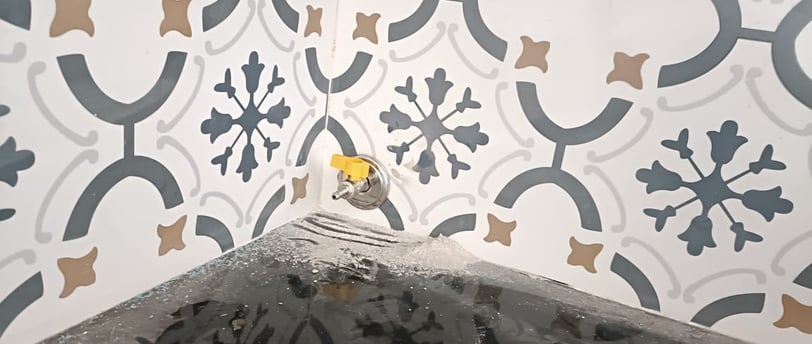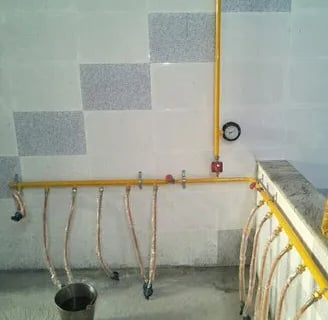The Ultimate Guide to Safe domestic Gas Pipeline Installation


Installing gas pipelines at home is a process that requires careful planning, skilled labor, and strict adherence to safety regulations. Whether you're building a new home or upgrading an existing system, ensuring the safety of your gas pipeline installation is critical for the well-being of your family and property. This guide will walk you through essential tips, safety standards, and best practices for safe domestic gas pipeline installation.
1. Understanding the Importance of Safety in Gas Pipeline Installation
Gas pipelines are an essential part of modern homes, providing fuel for cooking, heating, and other applications. However, improper installation or neglecting safety protocols can lead to gas leaks, fire hazards, or even explosions. Ensuring that the installation follows all regulatory guidelines and safety procedures protects your home and loved ones.
2. Hire Licensed and Certified Professionals
The first step to ensuring a safe gas pipeline installation is to hire a qualified professional. Licensed technicians are trained in the latest safety codes and are familiar with local regulations. They know how to install pipelines in a way that minimizes risks, avoids potential hazards, and ensures compliance with safety standards.
Tip: Always verify the credentials of the technician or company. Ask for their certification and experience in domestic installations.
3. Pre-Installation Safety Planning
Before any gas pipeline installation, a detailed safety plan should be in place. This plan involves assessing the layout of the house, the type of gas appliances in use, and the local building codes.
Home Layout: Identify the shortest and safest route for the gas pipeline.
Appliance Compatibility: Ensure that the gas appliances (stoves, heaters, etc.) are compatible with the gas supply.
Building Codes: Adhere to local safety regulations, which include clearance requirements and placement restrictions.
4. Choosing the Right Materials
Selecting the appropriate materials for your gas pipeline system is critical for long-term safety and efficiency.
Copper Pipes: Commonly used for their flexibility and corrosion resistance. They are suitable for low-pressure gas installations.
Steel Pipes: Known for their strength, steel pipes are ideal for high-pressure applications. However, they require proper sealing to avoid leaks.
Plastic Pipes: Typically used for underground installations due to their resistance to corrosion. However, they are not suitable for above-ground or indoor applications.
Each material has its pros and cons, and a qualified technician will advise on the best option based on your specific needs.
5. Installation Process: Step-by-Step Guide
A safe gas pipeline installation follows a systematic process to ensure that all safety measures are respected.
a. Planning the Route
The technician will design the most efficient path for the pipeline, avoiding areas that may be prone to damage or interference, such as electrical wiring or high-traffic areas.
b. Laying the Pipeline
Pipelines are laid according to the predetermined plan. Care is taken to avoid unnecessary bends or joints, as these can increase the risk of leaks.
c. Pressure Testing
Once the pipeline is in place, pressure tests are conducted to ensure that there are no leaks or weak points in the system. This is one of the most critical steps in the installation process.
d. Sealing and Insulation
The pipes are properly sealed and insulated to protect against external factors, such as moisture and temperature fluctuations. Insulation is essential, particularly for pipelines running through exterior walls or underground.
e. Final Inspection
A comprehensive inspection ensures that the entire system is functioning properly and that all safety protocols have been followed.
6. Post-Installation Safety Tips
Even after installation, regular maintenance and safety checks are crucial. Here are some tips to ensure long-term safety:
Regular Inspections: Schedule annual inspections with a licensed professional to check for leaks, corrosion, or other potential issues.
Gas Leak Detectors: Install gas leak detectors in key areas of your home, such as the kitchen and utility room, to provide early warning in case of a leak.
Know the Signs of a Leak: Educate your family on the signs of a gas leak, such as the smell of rotten eggs, hissing sounds, or dying plants near pipeline routes.
Emergency Plan: Create an emergency plan that includes shutting off the gas supply and evacuating the house in case of a gas leak.
7. Common Mistakes to Avoid
There are several common mistakes that homeowners make during gas pipeline installations that can jeopardize safety. Here’s what to watch out for:
DIY Installations: Installing a gas pipeline is not a DIY project. Always hire a professional to avoid costly and dangerous mistakes.
Ignoring Local Codes: Failing to follow local building codes can result in unsafe installations and fines.
Overlooking Maintenance: Neglecting regular maintenance can lead to dangerous gas leaks or system malfunctions.
8. Compliance with Local Regulations
Each region has specific codes and regulations that govern gas pipeline installations. These codes ensure that the installation is safe and conforms to the highest safety standards. Non-compliance can result in penalties and unsafe conditions.
Make sure your installation follows:
Building Codes: These dictate how and where gas pipelines can be installed in residential settings.
Safety Standards: Various national and local safety standards must be met, including proper ventilation, pipeline clearance, and pressure testing.
9. Emergency Preparedness
In the rare event of a gas leak or other emergency, preparedness is key. Knowing how to respond quickly can prevent serious harm.
Shut-Off Valve: Ensure that you know where the gas shut-off valve is located and how to operate it in case of an emergency.
Evacuation Plan: Have a clear evacuation plan in place and ensure all family members are aware of the steps to take if they smell gas or suspect a leak.
Emergency Contacts: Keep the contact information for emergency services and your gas provider easily accessible.
10. Conclusion
Safe gas pipeline installation is essential for any home, and it requires careful planning, professional expertise, and ongoing maintenance. By adhering to local regulations, choosing the right materials, and hiring licensed professionals, you can ensure that your home remains safe and efficient.
contact us at 9966106888
https://unitygaspipeline.com


Email Us
unitygaspipeline@gmail.com

At Unity Gas Pipeline Installation In Hyderabad, we are dedicated to enhancing the safety and comfort of your home with our expert LPG gas pipeline installations. Trust us to deliver reliable, efficient, and safe solutions tailored to your needs. Let us help you create a comfortable and secure living environment for you and your family.
Gas Pipeline Installation In Hyderabad & Secunderabad, Gas Pipeline Installation Service In Hyderabad & Secunderabad, Gas Pipeline Installation Service In Pragathi Nagar, Gas Pipeline Installation Service In Bachupally, Gas Pipeline Installation Service In KPHB, Gas Pipeline Installation Service In Panjagutta, Gas Pipeline Installation Service In Ameerpet, Gas Pipeline Installation Service In Sai Nagar, Gas Pipeline Installation Service In Moosapet, Gas Pipeline Installation Service In Kukatpally, Gas Pipeline Installation Service In Nizampet, Gas Pipeline Installation Service In Miyapur, Gas Pipeline Installation Service In Lingampally, Gas Pipeline Installation Service In Patancheru, Gas Pipeline Installation Service In Secunderabad, Gas Pipeline Installation Service In Banjarahills, Gas Pipeline Installation Service In Jubilee Hills, Gas Pipeline Installation Service In Madhapur, Gas Pipeline Installation Service In Hitech City, Gas Pipeline Installation Service In Kondapur, Gas Pipeline Installation Service In Gachibowli, Gas Pipeline Installation Service In Nallagandla, Gas Pipeline Installation Service In Tellapur, Gas Pipeline Installation Service In Manikonda, Gas Pipeline Installation Service In Chintal, Gas Pipeline Installation Service In Jeedimetla, Gas Pipeline Installation Service In Alwal, Gas Pipeline Installation Service In Malkajgiri, Gas Pipeline Installation Service In Sainikpuri, Gas Pipeline Installation Service In Ecil, Gas Pipeline Installation Service In Tarnaka, Gas Pipeline Installation Service In Uppal, Gas Pipeline Installation Service In LB Nagar, Gas Pipeline Installation Service In Dilsukhnagar.
Locations
Our Services
Call Us
© 2025 Unity Gas Pipeline Service. All Rights Reserved
